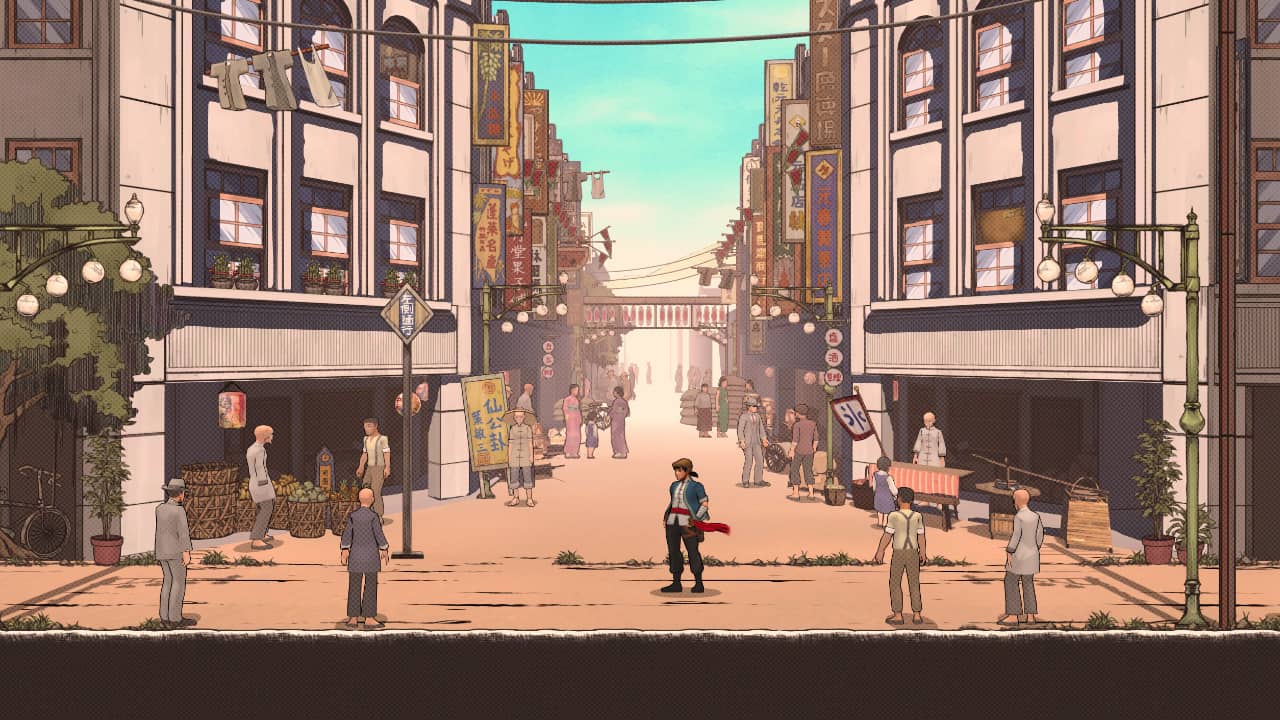Set in the early 20th century, The Legend of Tianding tells the tale of the ‘Taiwanese Robin Hood’ – a vigilante in Taipei City, wanted by the Japanese colonial forces.
This action platformer from CGCG and Neon Doctrine (Doors of Insanity) has you play the role of the titular hero as he attempts to rob the rich and give to the poor. Tianding doesn’t rely on any weapons (unless you include a sash), and can pretty much handle himself when it comes to kung fu.
The comic book sequences and general art style in The Legend of Tianding are so good that by the time I finished this preview experience, I wanted more storytelling, more platforming, more action, and stuffing my face on buns.
That’s testament to the developers, though bear in mind that this isn’t a narrative-driven adventure, but it’s a decent arc to follow. The aesthetics resemble a serial panel that would be present in the days of old newspapers. Yes, they still exist, darlings, but the smell of the printed page is becoming a thing of the past.
Where There’s A Will, There’s A Wang
Back to the plot. Tianding is like the Robin Hood of Taiwan (said that already), and he seeks justice with his fists, feet and sash for the people. He’s a pretty decent hero, too, unfazed with the fisticuffs the endures or jumping across rooftops.

In this The Legend of Tianding preview, he seeks to expose the corrupt tea merchant that’s brown-nosing the Japanese invaders. Besides grovelling to them and losing the respect of the people, the merchant’s business is shady, too, as you dive deep in the sewers to expose his master plan.
The action is portrayed through some classic side-scrolling action that involves brawling sections and platforming tactics. The revered double-jump is a leading character, with the best supporting role going to Tianding’s sash.
To sidetrack a little. As a non-animator, I can truly appreciate the effort that has gone into this garment. While I’ve left Tianding to fidget on the screen while I type this, his sash elegantly flows – utterly independent of his movements. It’s like a distant cousin of Dr Strange’s cape. Cloak. Whatever.
*Snaps fingers* we’re back in the room.
Tianding effortlessly casts this sash onto Indiana Jones-like hooks to gracefully swing across chasms and other nasties you don’t want to get involved with, but it also disarms enemies. A bit like Redeemer, you smack your assailant about the chops, giving them the old 1-2, then whip out your sash, take their weapon and beat them with it. Alternatively, they may have a gun. In that case, shoot them with it. Note that bullets aren’t infinite.
Wanna Fight? Fight Me
Combat in The Legend of Tianding is simple, and it’s very much a button masher. But that’s a good thing. This arcade-like approach makes it flow and allows you to focus on pulling off combos and juggling-like effects to pummel your opponents. Or you could do a Liu Kang across the screen, then double jump out of it like Tony Hawk – sans skateboard.

Initially, I played this on the keyboard, and while you can flip the mouse wheel up and down for the sash technique, by the time you earn manuals and unlock new moves, it makes sense to use a controller. Though don’t be put off if you’re allergic to controllers and think they’re for plebs.
Recalling that comment about flow, animation in The Legend of Tianding moves with the finesse of a kung fu master. Other than jumping all over the place, there will be environmental hazards that you have to pass, and they’ll cause you harm. To counter this, the evade skill is employed.
Roll or pirouette in the air – the movement flows like water, and you can connect your moves as if doing parkour. The only confusing part is Tianding will flash white which would seem he’s taking damage, when in fact, he’s peachy.
Damage, Uh, Damage, Uh
If you do take damage, and you will, there are checkpoints scattered about to fill up your stomach. If I can draw a quick comparison to another beautifully illustrated action platformer, not too dissimilar to The Legend of Tianding, The Company Man has the same mechanic to swig some coffee. Here, you stop for some steamed buns and tea. Lush.
Eventually, your special moves won’t be solely for the attacks, and there will be a sort of combo platforming sequence where you’ll glide across the screen, then before falling to your death, jump up to the next area. More importantly, though, these juggling antics work wonders when fighting enemies.

Besides health bars and subsequent health potions in the guise of buns, there’s a stamina meter for specials. This fills quickly, but can prove a slight challenge if you have to use these moves to reach an area. If you cock-up, you could end up sacrificing a bit of health. That’s not necessarily a bad design, just bad execution on the player’s part. Mine.
Scattered throughout the stages are chests. These will unlock permanent boosts such as the number of projectiles you can carry, how much damage you take from traps, and boosting your general well-being that you can now bin those ginseng supplements you got on sale.
Springer’s Final Thoughts
Some of the jumping sections can be a little awkward, and you have to combine your sash with the dragon kicks to get you a little boost up. Timing is critical, and with the added stamina gauge, repeating areas may irritate you.
Even when you don’t save at a checkpoint, the respawn points are relatively kind. That said, I should have finished this on the first play before exiting the game, as I found myself repeating areas I’d already done. Hopefully, that won’t remain in the full game.
It’s illegal to give a rating for previews. You’ll get locked up. However, to toy with the rules, if The Legend of Tianding plays out like what was on show in this preview, it’d get a 4/5. It’s bloody brilliant, and I can’t wait to play the full game – as and when it’s released.










